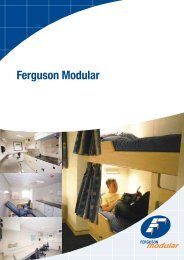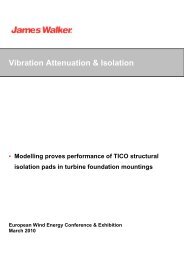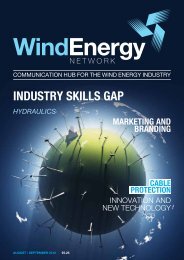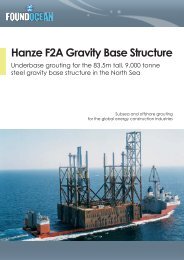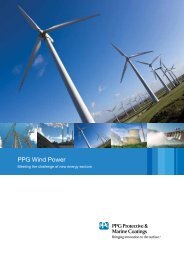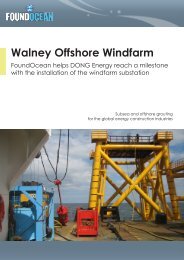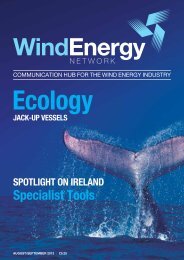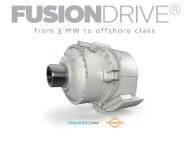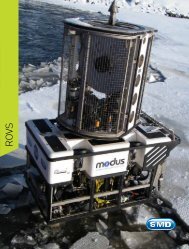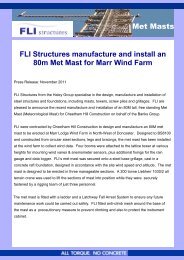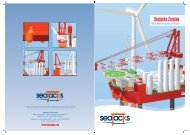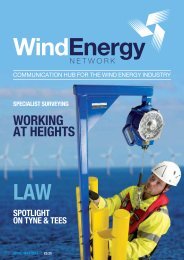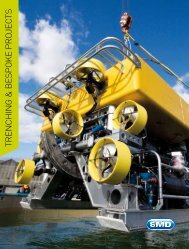JUNE/JULY 2013 | £5.25 - Wind Energy Network
JUNE/JULY 2013 | £5.25 - Wind Energy Network
JUNE/JULY 2013 | £5.25 - Wind Energy Network
Create successful ePaper yourself
Turn your PDF publications into a flip-book with our unique Google optimized e-Paper software.
Research & DevelopmentResearch & DevelopmentLifting the barrier to windfarm radar objectionsCould recent advances in radarmodelling expand the development ofwind farms worldwide?Reflections from rotating turbines cancause false plots on radar displays. Thismeans that thousands of wind turbinescannot be built because of potential radarinterference.Accuracy limitationsComputerised assessment tools can showwhether a radar is likely to be affected by awind turbine. Accuracy limitations of mosttools often means that wind turbines areunnecessarily objected to. There is ampleevidence to suggest that some modellingtools are over conservative.Online software developmentsRecent significant developments in PagerPower’s online software have included highresolution piecewise modelling, advancedterrain elevation algorithm, blade speedweighting and calibration. This increasesthe accuracy and reliability of assessments.Modelling and calibrationModelling has never been known tosuggest turbines won’t be detectedwhere the turbines have in fact beendetected. Conversely modelling hasshown that turbines will be detected andyet they have not affected the radar oncebuilt. Calibration is important because itconnects the modelling with real worldobservations.Calibration involves assessing operationalwind turbines and comparing thepredicted radar impact with the observedradar impact. The sensitivity of the modelis then adjusted so that the predictedimpact matches the observed impact.The best turbines for calibration are thosethat are detectable to radar by a smallmargin. In these cases false plots appearoccasionally and, in the case of analogueradar, video images are small. Calibrationindicates that modelling by some radaroperators is over conservative (betweenapproximately 10 and 20 decibels).Improvements to modelling should leadto more turbines (and taller turbines)becoming acceptable to radar operatorswithout technical mitigation being required.ExperienceThe Pager Power team has been workingwith wind developers and radar operatorsto identify, assess and resolve technicalproblems since 2002. We deliver aworldwide service and are proud to saywe have worked on 24% of wind turbinescurrently operating in the UK.Pager Powerwww.pagerpower.co.ukClick to view more info= Click to view videoConcrete GravityFoundationsRound 3 wind farm developments arelargely in deeper waters and furtheroffshore, with a mixture of seabedtypes. The different environment willrequire the deployment of alternativefoundation solutions to those that theUK market has predominantly used todate and alternative designs will needto be considered.The Concrete Centre, on behalf of theInterest Group for Gravity Foundations– Offshore <strong>Wind</strong>, has commissionedresearch projects to support the proprietaryresearch of the group’s solution providers.Carbon studyCommissioned by The Concrete Centre andcarried out by Arup and Vinci Construction,the study estimated the carbon footprint ofthe raw materials and other resources tobe used in the construction of a concretegravity foundation to support a 5MW turbinein 42m deep water.The study also includedconsideration of…• Transportation of materials to amanufacturing/construction facility• Resources used in the construction ofthe manufacturing facility• Resources used in the manufacture ofany bespoke vessels used forinstallation• Resources used during installation ofthe foundations• Resources used during maintenanceof the foundations• Resources used during deconstructionof the foundationsin Europe is produced almost entirelyfrom recycled materials, whilst this studyassumed that steel plate would beused for a steel jacket. Further detailshave been published in CONCRETEmagazine, and a pdf of the article can bedownloaded from the micro page usingthe link at the end of this article.Environmental impactassessmentCommissioned by The Concrete Centreand carried out by Marine Space, thestudy reviews the marine environmentalconsiderations for concrete gravityfoundations (CGF), including comparisonto foundation alternatives. The studyexplores the environmental effects andpathways associated with the variousphases of the lifecycle of CGFs in themarine environment including…• Ground preparation(if required)• Emplacement on the seabed• Scour protection (if required)• DecommissioningReview findingsThe review found that CGFs have anenvironmental footprint at the seabedsimilar to other deeper water foundationsolutions. The advantage of CGFs overalternatives is the lack of significant noiseemissions generated during their installationand emplacement. With increasedrequirements for consideration of noise inlegislative controls, underwater noise willbe a primary consideration for deepwatersolutions for Round 3 developments.Study findingsThe study found that the average carbonfootprint for six different concrete gravityfoundation (CGF) solutions was estimated tobe 1,190 tonnes CO2e per 5MW unit (with arange of 708-1,597 tonnes CO2e per 5MWunit). This compared with an estimatedcarbon footprint for a steel jacket solution of2,770 tonnes of CO2e per 5MW unit.The key driver for the difference in thecarbon footprints was the quantum andtype of steel within the different solutions.The concrete foundations incorporatesignificantly less steel than the steel jacketsolution. Moreover, reinforcement steelis used in the concrete solutions, whichCGFs solutions require no piling orhammering for installation, allowingmitigation of one of the major environmentalimpacts associated with offshore windfarmconstruction. This is both beneficial to theenvironment and mitigates a significantplanning/programme risk.The Concrete Centrewww.concretecentre.com/windClick to view more info28 www.windenergynetwork.co.ukwww.windenergynetwork.co.uk 29



